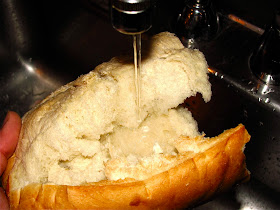Promises and pie crusts are made to be broken.
—Jonathan Swift
Not around here they ain't. I promised some people meatballs (you know who you are and why) and meatballs I am delivering.
To make a good meatball you must first prepare your sauce (aka gravy). Why? Because the sauce is what the meatballs are cooked in. At least mine are.
I never make a Red Sauce exactly the same way twice, but there are three ingredients that are always in there: plenty of extra virgin olive oil, garlic and pork. The pork (often a mixture of ribs and sausage, though here just the ribs) is browned so as to render some of its fat, then removed until the tomatoes go in. The dark spots you see here? Anchovies. I use them sometimes. Even if you wind up not tasting them, when they're in there I find I need to use less salt.
I won't go through the whole red sauce-making ritual, but just so's you know what else went into this particular one before the tomatoes, pork and meatballs did: You've got your onions, your celery, some diced prosciutto, salt and pepper, and carrots for a little sweetness (some people use sugar, but this has always seemed a better method to me).
I always make my meatballs the same way—and always make them while the sauce is cooking. (I am not unique in this way, as generations of my people walked this same path.) The ground meat you see here is two-thirds veal, one third beef. I know. Where's the pork? It's in the gravy, not the meatballs.
A loaf of bread, an open faucet. More crucial elements to a good meatball you will not find.
I do not use breadcrumbs. Never have. I soak a loaf of bread in water, then gently squeeze a lot of the water out and start tearing it apart. As for bread, I usually grab one of those soft loaves that a lot of supermarket bakeries make. The reason I like this bread is because even the crust breaks down when you wet it, and I use the crust. But most any bread will do.
If you click on this pic you will get a better idea what's going on. Look at the ring of meat and notice that the veal and beef has been mixed but only lightly. This is very important. A meatball mix must be handled gently (I only use my hands, by the way, never a utensil). Mix it only as much as it takes for the ingredients to come together, and that's it. Never overwork it. One of the reasons why meatballs can be tough, heavy and way too dense, rather than tender and light, is because they have been worked too hard.
As for the ingredients, this batch is a fairly big one. There are about two pounds of veal, a pound of beef, two eggs, about three-quarters of a loaf of wet bread and a good dose of milk, which I keep adding as needed to keep things moist. The only seasoning I use is Kosher salt and freshly ground black pepper.
Here's another pic worth enlarging. See how moist the mixture is? Just as important, notice that I do not try to get things completely smooth and uniform. If there are hunks of bread in the meatballs, fine, I like bread. It goes back to not overworking. Very important.
Next step is to fry up a small piece of meatball mix to make sure it's seasoned to your liking. With meatballs that are mostly veal you may find it necessary to use a little more salt than if pork was an ingredient.
Time to make the balls. Again, don't overwork them here either. Using only one hand, just pinch some mixture from the pile, roll it ever so softly using your fingertips for a couple seconds and that's it; into the olive oil-soaked hot frying pan they go. Don't compress the meat or roll it in your palms or anything like that. Remember, the idea is to keep things nice and loose.
Some people bake their meatballs; I only fry them. But I don't cook them, I only brown them a little. These meatballs are coming out of the pan right now. I know. They're raw. They're supposed to be.
This is how my meatballs look just out of the frying pan.
Here is where they cook all the way through. This sauce is pretty much done already and so the idea now is to simply allow the meatballs to cook in it. But they should never cook at a hard boil. Just keep things at a very gentle simmer, for maybe half an hour. Cooking them this way, I find, keeps the meatballs moist and prevents them from getting stiff.
Moist and juicy. Like so.
Oh, and before I forget. Always make sure to fry at least a few meatballs until they are fully cooked, then set them aside for snacking. You will be happy that you did this, I assure you. Sunday mornings when I was growing up, I woke to the aroma of two things: my mother's gravy and her fried meatballs. To get to the bathroom you had to walk through the kitchen, and so before I'd get to do my business I'd get to taste my mother's meatballs. Two of them, actually. The first was always right out of the plate of cooked meatballs on the stovetop, the second I dipped in the gravy. By the time day was done I'd have put away at least a dozen more.
Some years ago an associate attempted a numerical calculation of the meatballs I had consumed to that date. Unable to cope with the magnitude of digits in her charge, the project was abandoned, but not before the weight of it took its toll. I have a memory of the poor woman running down Tonnelle Avenue in Jersey City, half naked and screaming, incoherently as best I can determine, about how the giant meatballs and the flying monkeys were conspiring to take over New Jersey, or, at the least, Hudson County. It was a sorrowful ending to an otherwise promising endeavor.
As for my associate, she is still with us. Only, please, do your old pal Meatball a favor and do not under any circumstances show her this post.
There will be more meatballs in it for you.
I promise.
**********************************
THANK YOU VERY MUCH!
MISTER MEATBALL has been voted Best Food Blog of 2011 by the readers of the Portland Phoenix. I'm really grateful to everybody who voted for the blog. It means a lot, and I thank you all very, very much. Grazie mille! —MM
Reprinted from the Phoenix
Best Food Blog: Mister Meatball
Warning: Do not read the Mister Meatball blog on an empty stomach. You will get more hungry and your stomach may start to growl. The recipes Mister Meatball writes about — many of them Italian or Italian-influenced — are drool-worthy: polenta lasagne with meat sauce, farinata (a breadish thing made with chickpea flour), sesame seed cookies, and octopus salad, just to name a few. Easy-to-use recipes are interspersed with memories of growing up in New York City (he's a Mainer now) and other anecdotes. This is a guy you'd want to invite over for dinner (as long as he cooks).





































